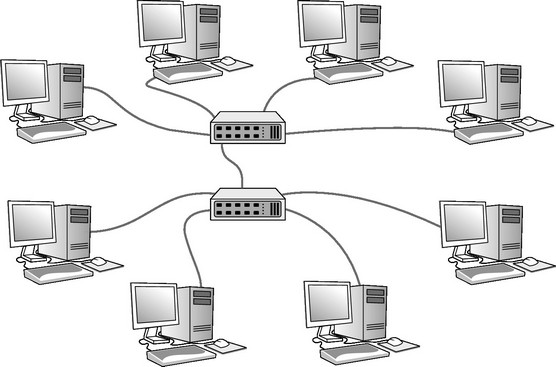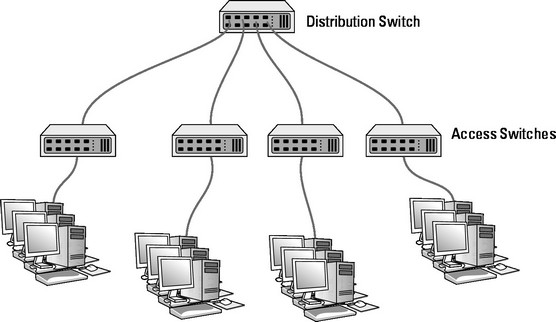What Type of Switch Is Used to Combine Multiple Network Connections Into a Single Link?
You need to know merely a few details when working with network switches. Here they are:
- Installing a switch is commonly very simple. But plug in the power string and then plug in patch cables to connect the network.
- Each port on the switch has an RJ-45 jack and a single LED indicator, labeled Link, that lights upward when a connection is made on the port.
If y'all plug ane end of a cablevision into the port and the other terminate into a computer or other network device, the Link light should come on. If information technology doesn't, something is wrong with the cable, the hub or switch port, or the device on the other end of the cable.
- Each port may take an LED indicator that flashes to indicate network activity.
If you stare at a switch for a while, yous can notice out who uses the network nearly by noting which activity indicators flash the most.
- The ports may also have a collision indicator that flashes whenever a package collision occurs on the port.
It's perfectly acceptable for the collision indicator to flash now and then, just if it flashes a lot, you may have a problem with the network:
- Commonly, the flashing ways that the network is overloaded and should be segmented with a switch to ameliorate functioning.
- In some cases, the flashing may be caused by a faulty network node that clogs the network with bad packets.
Why is it called a switch?
You lot might be wondering why a network switch is called a switch. After all, in your everyday experience, a switch is used to plough something on and off. But network switches don't plow networks on and off.In networking, a switch is a device that receives incoming packets of information from the network and determines where each packet should be sent. In that sense, a network switch is more like a railroad track switch than a light switch. Instead of turning something on or off, a network switch determines which of several tracks a particular parcel of information should exist sent to.
Consider a small switch with eight ports, numbered 1 through eight. When the switch is powered on, it pays attention to the devices that it can connect to on each of its viii ports. It does this by studying the Ethernet packets that arrive on each port and taking note of the sender'south address independent in each packet.
The network switch keeps rail of which device is attached to each of its ports. When a package arrives on a network port, the switch looks at the recipient's address contained in the parcel. The switch and then determines which port the recipient is on and sends the packet to that port.
Thus, switches efficiently manage the travel of packets throughout a network by switching each parcel traveling on the network through the correct cables, ensuring that each package arrives at its destination.
Comparing managed and unmanaged network switches
Not all switches are created equal. Some switches are designed for very small networks in homes or single-function businesses. Small-scale networks are so unproblematic to manage that the switch itself doesn't require any management or configuration of its own. You only plug all the computers into the switch, and the network takes care of itself.In larger networks, notwithstanding, switches have a much more complicated task to do. In these environments, you lot need the ability to monitor and configure the behavior of each of the switches in the network. Switches that provide this adequacy are called managed switches . Switches that do not provide this adequacy are chosen unmanaged switches .
A managed switch has an IP address of its own and provides a web-based direction panel that y'all can admission by pointing your favorite web browser to the IP address of the switch. After you've logged in to the management console, you can do things such as configure each port for dissimilar types of network traffic, view the corporeality of traffic on each port, and monitor each port'due south operation, as well equally the overall performance of the switch.
As a full general rule, if your network requires more a single switch, you lot should apply managed switches. Managed switches are more expensive than unmanaged switches, but when your network grows large enough to require more than ane switch, yous'll appreciate the benefits that managed switches provide.
Daisy-chaining network switches
If a single switch doesn't take enough ports for your entire network, you tin can connect switches past daisy-chaining them, as shown below. (Notation that although you lot can daisy-concatenation unmanaged switches, information technology's a good idea to employ managed switches if your network is large enough to require more than one switch.)  You tin daisy-chain network switches together.
You tin daisy-chain network switches together.
On most switches, it doesn't matter which port you use to daisy chain to another switch. Just pick a port on both switches and use a patch cable to connect the switches to each other via these ports. And if your switch has ports with differing speeds, use the fastest ports to connect the switches to i another.
If your building is prewired and has a network jack near each desk, you lot can utilize a small switch to connect two or more computers to the network by using a unmarried jack. But use ane cable to plug the switch into the wall jack and then plug each computer into ane of the switch's ports.
Stacking network switches
Some network switches, called stackable switches , tin be expanded by adding additional switch modules that add boosted ports to the switch. The additional modules may be in the course of physically separate switches that are connected via special interconnected ports, or they may exist modules that tin be inserted into a larger chassis.Stackable switches are by nature managed switches, and the defining feature of a stackable switch is that all the switches connected together into a unmarried stack are managed as if they're a unmarried network switch.
For example, a stackable switch may be initially configured with simply a single module that provides 48 switch ports. If you demand additional ports, you tin can add a second module with 48 additional ports, creating a single switch with 96 ports.
Stackable switches are more expensive than non-stacking switches, but the simplicity of managing one large switch rather than managing multiple smaller switches may justify the added cost.
Looking at distribution switches and access switches
A network large plenty to require more than than one switch may as well be large enough to require several singled-out types of switches:- Access switches: An admission switch is a switch that typically has a large number of 1 Gigabit (Gb) ports whose job is to connect private devices such as computers and printers to the network.
For case, if your visitor has 100 employees, and y'all have wired two Cat-5e cables to each user'due south desk-bound, y'all'll need at least 200 ane Gb switch ports to back up these users. You lot'll also need a few extra ports for things similar printers and Wi-Fi access points.
Your network design may end upward with a total of five 48-port access switches, providing a full of 240 1 Gb ports to support the 100 users.
- Distribution switches: A distribution switch is a switch that isn't designed to directly support end users. Instead, information technology's designed to connect the access switches to each other and to your servers. Considering the purpose of distribution switches is to manage the aggregate traffic from all the access switches, distribution switches are sometimes called aggregation switches .
Often, a distribution switch uses x Gbps ports rather than 1 Gbps ports. The added speed is helpful because each port on the distribution switch carries much more data than each port on the access switches. The access port switches should too be configured with a few 10 Gbps ports, which are used to connect to the distribution switch.
- Cadre switches: The largest networks may likewise utilise dissever core switches, which are used to connect the distribution switches. Cadre switches manage traffic between distribution switches.
 Distribution and access network switches.
Distribution and access network switches.
Desire to learn more than? Here are 9 things yous should keep in your network closet.
Source: https://www.dummies.com/article/technology/information-technology/networking/general-networking/an-introduction-to-network-switches-138109
0 Response to "What Type of Switch Is Used to Combine Multiple Network Connections Into a Single Link?"
Post a Comment